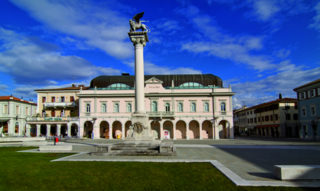
Following the partial demolition of the fortress walls in the mid-19th century, the area between the historic centre and the new expansion of the city towards the west acquired a growing centrality in city life, creating a real square: thus Piazza Unità d'Italia was born at the end of the 19th century.
This space was soon enriched with monuments: on 21 April 1924, the monument to the Redemption was inaugurated, a work of artist Giovanni Battista Novelli (1879-1965), in the open space in front of the theatre. It consists of a marble column with the lion of San Marco resting on top, in memory of the foundation of Gradisca by the Republic of Venice. On the base of the monument four bronze medallions mention historical events of Gradisca. Shortly after the column to the Redemption, we find the monument to Marziano Ciotti, also by Novelli, placed there in 1932.
The west front of the historic centre, not very noble and until then hidden by the defensive walls, was transformed. With the post-war reconstruction, the façades of the buildings that now house the historic Gradiscan cafés were redone and in 1925 a new main front of the theatre was built, facing the square. This is how the architectural scenes were created that can still be admired today.


